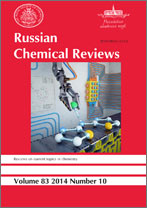|
This article is cited in 15 scientific papers (total in 16 papers)
Paramagnetic Shift Reagents in Nuclear Magnetic Resonance Spectroscopy
I. Ya. Slonim, A. Kh. Bulai
Research Institute of Plastics, Moscow
Abstract:
The physical foundations and the applications of a new method in nuclear magnetic resonance spectroscopy — the simplification of spectra by means of paramagnetic shift reagents, complexes of lanthanides with diketones — are examined, and data given on the properties of the most widely used reagents. The discussion covers the mechanism of interaction of the shift reagent with the organic compound (substrate), the dependence of the displacement of the signals on the concentration of the components and the temperature, the equilibrium in the reagent–substrate system, the effect of the nature of functional groups in the substrate, of the lanthanide ion, and of the ligand in the reagent on the magnitude of the shift in the n.m.r. spectra, the dependence of the shift and the line width on geometrical factors, and the effect of the shift reagent on spin–spin coupling constants. The use of shift reagents in the nuclear magnetic resonance of protons and other nuclei is considered briefly. The paper includes a summary of compounds whose spectra have been studied in the presence of shift reagents and also 348 references.
Citation:
I. Ya. Slonim, A. Kh. Bulai, “Paramagnetic Shift Reagents in Nuclear Magnetic Resonance Spectroscopy”, Usp. Khim., 42:11 (1973), 1976–2006; Russian Chem. Reviews, 42:11 (1973), 904–921
Linking options:
https://www.mathnet.ru/eng/rcr2668https://doi.org/10.1070/RC1973v042n11ABEH002774 https://www.mathnet.ru/eng/rcr/v42/i11/p1976
|


| Statistics & downloads: |
| Abstract page: | 110 |
|





 Contact us:
Contact us: Terms of Use
Terms of Use
 Registration to the website
Registration to the website Logotypes
Logotypes









